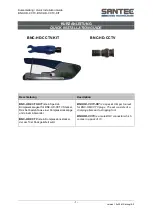
Hand Crimp Tool for Avikrimp™ /Insulkrimp ™ Terminals and Slices
Doc No: ATS-640160036
Release Date: 06-25-12
UNCONTROLLED COPY
Page 3 of 4
Revision: A
Revision Date: 06-25-12
BUTT SPLICE
TERMINAL
Figure 3
WIRE
WIRE TAB
Crimping Butt Splices
1.
Position the splice into the nest.
2.
Partially close the tool to hold the splice in place.
3.
Insert the properly stripped wire into the splice. The wires end
should butt against the tab in the terminal. See Figure 3.
4.
Continue to close the tool handles until the anti-backup ratchet
releases. Allow the handles to open.
5.
Remove the crimped splice. Inspect for proper crimp location.
6.
Rotate the butt splice terminal 180
°
, so that the opposite end of
splice is in the nest.
7.
Repeat steps 1 thru 4.
Maintenance
It is recommended that each operator of the tool be made aware of,
and responsible for, the following maintenance steps:
1.
Remove dust, moisture, and other contaminants with a clean
brush, or soft, lint free cloth.
2.
Do not use any abrasive materials that could damage the tool.
3.
Make certain all pins; pivot points and bearing surfaces are protected with a thin coat of high quality machine
oil. Do not oil excessively. Light oil (such as SAE30W oil) applied at the oil points, shown in Figure 4, every
5,000 crimps or 3 months, is recommended.
4.
Wipe excess oil from hand tool, particularly from crimping area. Oil transferred from the crimping area onto
certain terminations may affect the electrical characteristics of an application.
5.
When tool is not in use, keep the handles closed to prevent objects from becoming lodged in the crimping dies,
and store the tool in a clean, dry area.
Miscrimps or Jams
If the tool ever becomes jammed in a partially closed position,
DO NOT
force
the handles open or closed.
The tool will open by lifting the ratchet release
lever. See Figure 5.
Tool Handle Preload
Tool handle preload should
NOT
require adjustment upon receipt of tool.
This hand tool is set from the factory to a preload that will fully close the tool jaws without excessive force from the
operator. Over the life of the tool the tool linkage can wear and handle preload force may decrease and preload can
be adjusted. It is the operator’s responsibility to periodically perform a tensile pull test on the crimped wire. If the
pull test value falls below the specification, the preload should be adjusted. If after adjustment, the crimp does not
meet the pull test value, then the tool should be replaced.
Figure 5
RATCHET RELEASE
LEVER
Figure 4






















